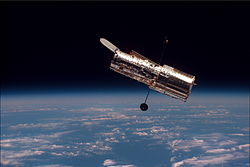Nautilus Deep Space Observatory
 | |
| Mission type | Exoplanet observation |
|---|---|
| Operator | University of Arizona |
| Website | nautilus-array |
Nautilus Deep Space Observatory (NDSO) (also known as Nautilus array, Nautilus mission, Nautilus program, Nautilus telescope array and Project Nautilus) (A Giant Segmented Space Telescope Array for a Galactic Biosignature Survey) is a proposed deep space fleet of space telescopes designed to search for biosignatures of life in the atmospheres of exoplanets.[1][2][3][4]
Daniel Apai, lead astronomer of NDSO from the University of Arizona, and associated with the Steward Observatory and the Lunar and Planetary Laboratory, commented, "[With this new space telescope technology], we will be able to vastly increase the light-collecting power of telescopes, and among other science, study the atmospheres of 1,000 potentially earth-like planets for signs of life."[1]
History
The NDSO mission is based on the development of very lightweight telescope mirrors that enhance the power of space telescopes while, at the same time, substantially lowering manufacturing and launch costs.[5] The mission proposes to launch a fleet of 35 such space telescopes, each one a 14 m (550 in) wide spherical telescope, and each containing an 8.5 m (330 in) diameter lens. Each of these space telescopes would be more powerful than the 6.5 m (260 in) mirror of the James Webb Space Telescope, the 2.4 m (94 in) wide mirror of the Hubble Space Telescope, and the 1.1 m × 0.7 m (43 in × 28 in) mirror of the Ariel space telescope combined.[1][6][5] The NDSO telescope array, when used all together, would be equivalent to a 50 m (2,000 in) diameter telescope.[1] With such telescopic power, the NDSO would be able to analyze the atmospheres of 1,000 exoplanets up to 1,000 light years away.[1]
In January 2019, the NDSO research team, which includes Daniel Apai, Tom Milster, Dae Wook Kim and Ronguang Liang of the University of Arizona College of Optical Sciences,[5] as well as Jonathan Arenberg from Northrop Grumman Aerospace Systems, received $1.1 million support funding from the Moore Foundation in order to construct a prototype of a single telescope, and test it on the 1.5 m (61 in) Kuiper Telescope before December 2020.[1]
Spacecraft
To be determined.
See also
- SISTINE - another way to search for life on exoplanets
References
- ^ a b c d e f University of Arizona (2 August 2019). "A new lens for life-searching space telescopes - University of Arizona researchers have designed a new kind of telescope that is a cheaper, lighter and more powerful option than creating telescopes using ever-larger mirrors. With a fleet of the newly designed space telescopes, they aim to scour a thousand potentially earth-like planets for signs of life". EurekAlert!. Retrieved 5 August 2019.
- ^ "A Thousand Earths: A Very Large Aperture, Ultralight Space Telescope Array for Atmospheric Biosignature Surveys". The Astronomical Journal. 158 (2). 29 July 2019. doi:10.3847/1538-3881/ab2631. Retrieved 5 August 2019.
{{cite journal}}: CS1 maint: unflagged free DOI (link) - ^ Apai, D.; et al. (2018). "Nautilus DeepSpace Observatory: A Giant Segmented Space Telescope Array for a Galactic Biosignature Survey" (PDF). Universities Space Research Association. Retrieved 5 August 2019.
- ^ Apai, D.; et al. (1 February 2018). "Nautilus Deep Space Observatory: A Giant Segmented Space Telescope Array for a Galactic Biosignature Survey". Harvard University. Retrieved 6 August 2019.
- ^ a b c Wallace, John (5 August 2019). "Multi-order diffractive optical elements could lead to extremely light space telescopes - University of Arizona Project Nautilus aims to create a space telescope that can survey transiting exo-earths for biosignatures 1000 light years away". Laser Focus World. Retrieved 6 August 2019.
- ^ Staff (2019). "Nautilu: A Revolutionary Sapce Telescope - A very large aperture, ultralight space telescope for exoplanet exploration, time-domain astrophysics, and faint objects". Nautilus-Array.space. Retrieved 6 August 2019.


